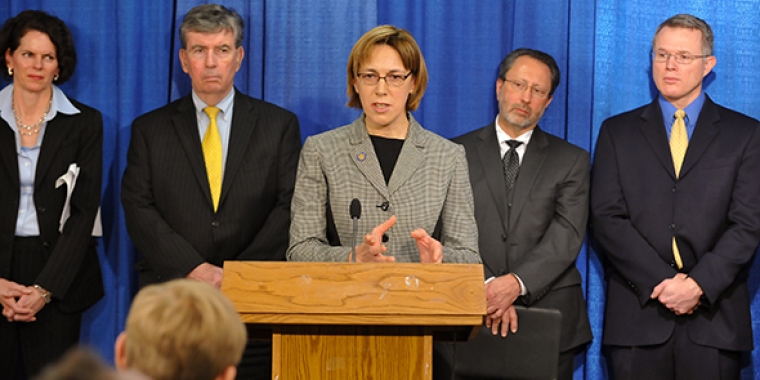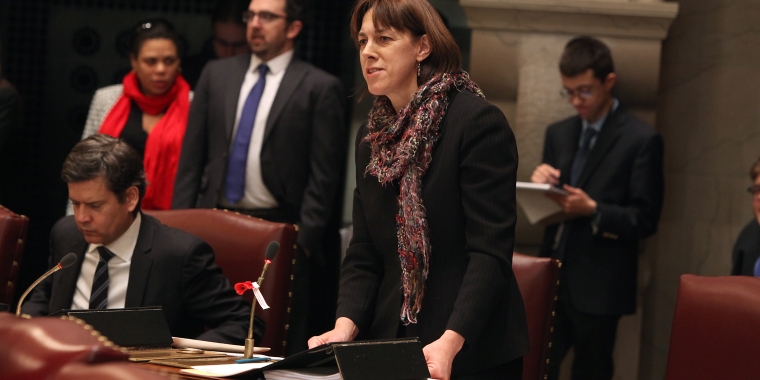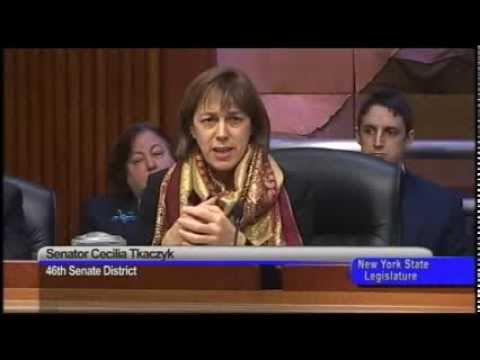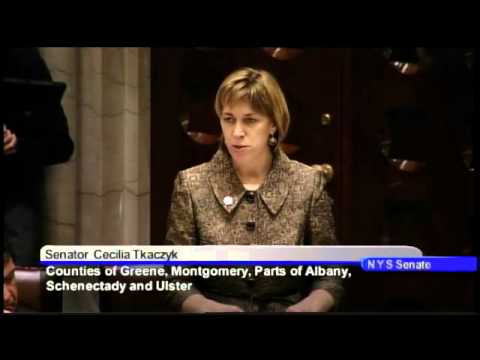
Senator Tkaczyk, Local Legislators, Parents and Advocates Call for Action to Save Vulnerable Public Schools
Cecilia Tkaczyk
February 20, 2013
-
ISSUE:
- Education

State Senators and Assemblymembers from the Capital Region today called for increased education aid to save public schools that have been pushed to the edge of insolvency by recent budget cuts.
The elected officials noted public schools have absorbed $2.7 billion in budget cuts in 2010 and 2011. Those cuts were especially devastating for high needs districts, where the cuts per pupil were much higher than for high-wealth districts.
To compensate, schools have already taken drastic measures. A statewide poll conducted by the New York State Council of School Superintendents showed that 87 percent of school districts have cut teachers; more than 1/3 have cut art and music programs; one-quarter have cut back on honors classes and many schools have had to cut both remedial and advanced education programs, as well as sports programs.
State Senator Cecilia Tkaczyk said, “Governor Cuomo has led the way in revitalizing our state’s economy and ensuring a vibrant economic future. A strong, well-funded public education system is absolutely necessary to prepare the next generation of New Yorkers for the high-tech jobs of the future. The proposals we’re making today will provide an investment in our children, without adding to the crushing burden faced by property taxpayers.”
In a letter to Governor Cuomo and the leaders of the five legislative conferences, the Capital Region legislators proposed a number of initiatives to enhance education aid and restore funding that had been eliminated through the Gap Elimination Adjustment (GEA). The GEA is a cut in state education aid that former-Governor Paterson implemented, and has meant cuts of over $305 million for Capital Region schools in state education aid. The proposals include:
- Distribute the $203 million in Fiscal Stabilization Funding through an equitable restoration of GEA funds that ensures prioritization of high needs and average need school districts in all regions of the state;
- Reallocate the $50 million in management efficiency and performance improvement grant funds to the GEA restoration distribution;
- Ensure that any additional money targeted for bullet aid (more than $41 million in the last two budgets) or any unused funds from the 2012-13 competitive grant allocation go to the GEA restoration distribution;
- Adjust the formulas for GEA restoration and additional foundation aid to maximize equity based upon fiscal capacity and student need, and
- Add $350 million in new school aid funding and prioritize high and average needs districts.
State Senator Neil Breslin said, "It is critical we make the necessary investments in education. Our local school districts simply cannot absorb any more cuts. These cuts have already had a negative impact on our students with numerous educational programs being eliminated. Without additional state aid, our local schools will not be able to provide the top notch education our students deserve."
Assemblywoman Patricia Fahy said, "I strongly recommend that the Governor's proposed $889 million increase in education funding be dedicated to increasing foundation aid and restoration of the Gap Elimination Adjustment. While I am pleased to see an increase in education funding, this increase - even at this size - will not solve the serious deficits facing school districts and additional aid is needed to cover escalating costs."
Senator Terry Gipson said, “Our schools have already tightened their belts through administrative efficiencies and sacrifices. More than 75 percent have implemented salary freezes or pay cuts for superintendents and more than half have negotiated concessions with local teachers unions and more than 40 percent have reduced central and administrative positions. Any additional cuts will dramatically impact our children's education."
Assemblyman John McDonald said, “In talking to the nine school districts where the children of the 108th Assembly District reside, each and every school district has taken drastic actions to reduce costs during these times of less-than-expected state aid for education. Hundreds of jobs have been cut, buildings closed, salaries frozen and dozens of additional cost cuts implemented. However, these cuts are not able to outpace the spiraling health care and pension costs, especially in this reduced aid environment. My concern is that this path is not sustainable going forward, especially as fund balances are near empty and options are few and far between. We need to build upon the Governor's proposed increases in his initial budget in order to prevent our education system from falling into deeper despair.”
Assemblyman Angelo Santabarbara said, "It is our responsibility to provide our children with the tools they need to be successful in the workforce, but right now, our schools are in a state of crisis. Past budgets have forced schools to cut their budgets to the bone. Teachers have been laid off, arts and music programs cut, and class options narrowed. We are asking that hard-hit rural and high-needs, low-wealth schools receive more funding because they have been hit the hardest, and taxpayers in those districts just cannot afford to make up the difference."
Assemblyman Phil Steck said, “I commend the Governor for putting more funding into education, but we certainly want to work with our two former school board members, Cecilia Tkaczyk and Pat Fahy, to have any additional funding used in a manner that will best benefit the school districts of New York State.”
Billy Easton, Executive Director of the Alliance for Quality Education (AQE) said, "The fact that Capital District and Hudson Valley legislators from both houses and both sides of the aisle are standing together to call for additional school aid targeted to high and average need districts is a reflection of the reality that without additional funding, our school children will lose yet more teachers and programs. The Alliance for Quality Education applauds these legislators and strongly supports their proposal. Without it, our schoolchildren will no doubt endure another round of classroom cuts."
Timothy G. Kremer, Executive Director of the New York State School Boards Association, said, "New York has to make state aid to schools its number one budget priority. The future health and prosperity of our state depends on the ability of our schools to make students college and career ready. Sadly, the Gap Elimination Adjustment and state aid cap are eroding schools' ability to do exactly that.”
Robert Reidy, Executive Director of New York State Council of School Superintendents, said, “Across New York State, superintendents, board members, educators and families fear that their schools will never again be able to match the opportunities they are providing to students now. Financial and educational insolvency are on the horizon for many districts. We are grateful for the leadership of the Capital Region legislators and their support for more funding to help our students and taxpayers.”
Brian Hassett, President & CEO of United Way of the Greater Capital Region said, “United Way believes that the investments that we make in young people today will pay off for years to come. Our State's economic and social conditions are strongly connected to our capacity to maintain an educated workforce, with skilled employees who provide for their families and participate in the local economy. When one child gains a bright start in life through access to educational opportunities, there's a good chance he or she will enjoy a productive future. When that happens, everybody benefits.”
Dr. Rick Timbs, Executive Director of the Statewide School Finance Consortium said, "Our legislators simply ask for the state to make a critically well-timed and long overdue reasonable step to support schools district with the funds they need to achieve their mission. The diminution of adequate state support and the maintenance of our current inequitable support system for struggling public school districts has gone on too long. School communities with few local resources and significant challenges must be saved from fiscal and/or educational insolvency. Obviously, to provide every student, no matter where they live, their chance for a prosperous future, requires the state to provide a desperately needed and appropriate investment. The state's performance speaks volumes to these children. These forward thinking legislators rightfully call on the state to respond with an adequately funded and equitably distributed state aid plan matched to the newly expanded mission of schools districts, and quickly."
Share this Article or Press Release
Newsroom
Go to Newsroom
Senator Tkaczyk Questions DEC Commissioner on Fracking Wastes
February 24, 2014

Senator Tkaczyk Comments on the 2013-2014 Budget
February 24, 2014

